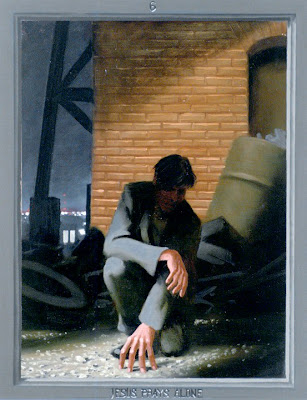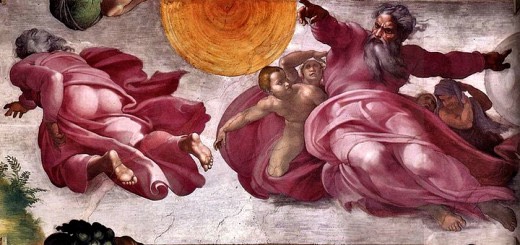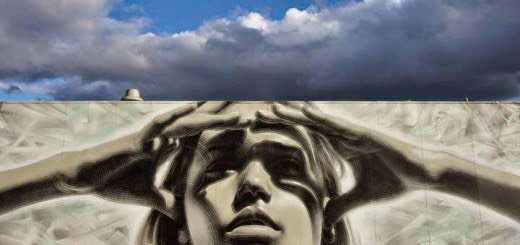Jesus, from the last dinner to arrest. The passion of a Christ Queer
Text by Kittredge Cherry taken from The Passion of Christ: A Gay Vision (The Passion of Christ: a gay vision), illustrations by Douglas Blanchard, Apocryphile Press, 2014, 154 pages, freely translated by Silvia Lanzi
"As they dined ... one of the disciples, what Jesus loved, was at the table by his side."Giovanni 13: 2, 23. Friends meet for an intimate dinner in" The Last Supper "from" The Passion of Christ: to Gay Vision, "a series of twenty -four paintings by Douglas Blanchard. The contemporary figure of Christ dinner with twelve people, the classic twelve diecepoli, but they are a multiracial group of many ages, orientations and gender identities.

The Last Supper (from The Passion of Christ: to Gay Vision) by Douglas Blanchard. Leslie-Lohman Museum of Gay and Lesbian Art collection
An elderly black woman sits next to a white businessman. A drag queen with high heels holds a man's hand. The face of Jesus seems practically the same as when he preached in the temple ... impassively. Wraps the arms around the men next to him. The entire group is united by the touch, but it is not completely united. The emotions expressed range from surprise to regret, and everyone looks in a different direction.
The dishes are full for the Seder (typical Jewish ritual meal) of Easter, with the Matzo bread, a boiled egg, and the roast of lamb. A sigolo glass of blood red wine stands out against the colors tending to gray, mentioning the sacrifice to come. The room is simple, illuminated only by a naked bulb light bulb. They are sitting in a way that invites those who look to reach them at the table.
All four gospels describe the final meal that Jesus ate with his disciples before being arrested. The biblical tales of the Last Supper are full of dramatic details and the dialogue between and make it possible to imagine what happened on that fateful evening. Jesus had announced to the frightened disciples that some of them would betray him.
Furono scioccati ancora quando egli identificò il pane e il vino come il suo corpo e il suo sangue, esortandoli a mangiare e bere la loro parte di esso. Dando un nuovo significato al pasto di Pasqua, egli ha aiutato a prepararli alla sua imminente morte. Ha riassunto i suoi insegnamenti sull’amore e ha dato loro un comandamento nuovo: che vi amiate gli uni gli altri come io ho amato voi. Ha pregato per i credenti del presente e del futuro. Ha detto che l’amore più grande è dare la vita per i propri amici.
Invitando i suoi amici a “fare questo in memoria di me” Gesù ha istituito un sacramento e ha investito tutti i pasti con un vivido senso della presenza di Dio. I cristiani rivivono l’Ultima Cena ogni sigola volta che celebrano il rituale conosciuto come Eucaristia, comunione o la Cena di Dio. Il pasto sacro è un atto centrale di adorazione nel quale i credenti ricordano Gesù e mangiano lo spirito di Dio. Nel quadro di Blanchard, un bicchiere è ancora pieno di vino, il che significa che Gesù non l’ha ancora passato ai suoi amici dicendo “Questo calice è la nuova alleanza nel mio sangue.”
The man who supports his head on Jesus must be the anonymous "disciple that Jesus loved". The beloved disciple is mentioned five times in the Gospel of John. The term implies that Jesus was in love with him, and for centuries some interpreters suggested that they had a homosexual relationship. The Bible describes how the beloved rested his boss on the chest of Jesus during the last dinner. Blanchard puts them in a position that echoes medieval paintings and sculptures, such as the 14th century Johannesminne of the Tenth century of the Oberschwaben master. Their homo-affective attraction has been highlighted by today's pro-Lgbt biblical artists and biblical sweats, but their relationship naturally merges within the group. Some also like to speculate on the homoerotic nuances of the relationship between Jesus and Judas, the disciple who betrayed him. But it's not the thing on Blanchard on. It is not even possible to identify Judas in his last dinner.
L’Ultima Cena è uno dei più popolare (e molto spesso parodiati) soggetti dell’arte. Gli artisti di solito si focalizzano o sull’annuncio del tradimento o, come Blanchard, sull’istituzione dell’Eucaristia. I dipinti dell’Ultima Cena datano ai primi affreschi cristiani del II secolo nelle catacombe di Roma, sebbene alcuni studiosi affermino che le scene ddella cena nelle catacombe mostrino un futuro pasto in paradiso promesso da Cristo. Per i primi mille anni della storia cristiana gli artisti hanno teso ad andare dall’Ultima Cena alla resurrezione. L’Eucaristia era celebrata come una festa della vita invece che una rievocazione della sua morte. Il pane e il vino non erano il Cristo crocefisso, ma il Cristo risorto. Durante il Rinascimento divenne un soggetto molto popolare. L’Ultima Cena di Leonardo Da Vinci, degli anni novanta del 1400 continua ad essere uno di più famosi dipinti di tutti i tempi. E ha scatenato una serie infinita di imitazioni, dal sublime al ridicolo. Alcuni l’hanno usato per fare affermazioni politiche come “L’Ultima Cena di Yo Mama” tutta al femminile dell’artista giamaicana-americana Renee Cox e “La Prima Cena” di Susan Dorothea White dall’Australia. Interpretazioni moderne dell’Ultima Cena sono state fatte da molti rinomati artisti incluso Salvador Dali, che ha usato surrealismo e simmetria per ritrarre il mistico pasto.
By presenting a complex and modern vision of the Last Supper, Blanchard makes room for those who look at, because they live in the scene, which may have become monotonous because it is too familiar. Artists such as Elisabeth Ohlson Wallin and Becki Jayne Harrelson have created queer versions of the Last Supper, referring to Leonardo's famous composition and replacing the protagonists with contemporary LGBT people. Blanchard goes beyond re-containing the entire composition. His touches queer include not only the beloved disciple, but also the drag queen with high heels. He puts it right in front of courtesy. But his last dinner is not just an LGBT party. Queer people are integrated into a mixed group. Jesus willingly accepts all types of people to the sacred meal where love unites people with God and with each other, nourishing body and spirit. During the last dinner Jesus taught his friends love. Soon his love should have been tried.
"This is my body offered for you. Do this in memory of me"Luke 22,19. The friends of Jesus did not know that this would be their last meal with him, even if he had tried to prepare them. All the most intimate friends were there, including what Jesus loved. Jesus, with a curled up his beloved disciple on his chest, spoke of love, of betrayal, and even more of love. Jesus said that he went away and spied them on to love them.
The greatest love, he told them, was to give life for their friends. He had taken the bread and said something totally unexpected: take, eat; This is my body. Then he had taken a glass by saying, you drink, all of you, this is my blood. He gave and they completely received. An act of true communion. The wine was sweet, with a touch of bitterness. Jesus, thanks because it feeds me!
Jesus prays alone
"He threw himself to the ground; And he prayed that, if it were possible, that hour passed beyond him."Marco 14, 34. A man claws the ground in a very deep spiritual anguish in" Jesus prays alone ". His face is lost in the dark - it could be anyone - but his tortured hand is illuminated in front and in the center in complete importance. Jesus is kneeling, completely alone, on a roof with garbage bins and bricks. Urban where a man only struggles with an impossible dilemma: betraying his most intimate or dying creed.

Jesus prays alone (from the Passion of Christ: to Gay Vision) by Douglas Blanchard
The simplicity of the image is of an immediate impact. It is the only picture of Blanchard's passion series in which Jesus is alone. Even in death Jesus is shown with other bodies, but here everyone has abandoned him, and God is not visible. Loneliness is absolute. The painting impresses many of those who look at him more than the scenes of explicit violence that follow. The artist captures the emotional anguish of Christ and makes it close and personal, leaving the viewer only with Jesus. With this picture Blanchard borrows high contrast lighting, a gloomy urban environment, and the fatalist noir fatal mood, making it an almost cinematic image.
In the Bible, Jesus and his friends, Getsemani Garden arrive after the Last Supper. He confided to them that he was "deeply saddened, until his death" and asked his friends to pray with him, but they fell asleep. Jesus knew that his ministry would conflict him in conflict with the authorities who wanted to arrest and kill him. It was so upset to sweat blood. Then he chose not to escape from the heartbreaking journey he had in front of him. The condemned prophet would not have denied what he believed in fleeing and hiding. Abandoned by the sleeping friends, he was left alone to pray to God still and again: "If it is possible, I pass this glass to me, but not what I want, but what you want". The episode shows that Jesus is not the puppet of God or a victim of circumstances, but one who acts freely, making his moral decisions.
"Jesus prays alone" represents a turning point in Blanchard's relationship with his passion series, which he started painting in 2001. He had finished four September eleven panels, when the diverted planes crashed in the World Trade Center near his study by the Lower East Side. Shocked, he saw terrorists attacking the roof of his apartment in the East Village. The religious motivation of the attacks of that day, Blanchard completely detached himself from religion. The artist is aware of having started using the passion series to resolve his spiritual conflict. Jesus, with his agony on the roof, assumes the pains that extend for the 21st century.
The artists mostly ignored the scene of the inner tumult of Jesus until the rise of individualism in the Renaissance. Then the subject, often called "agony in the garden", became gradually more popular. A remarkable modern version was painted by the French post-impressionist Gauguin, whose intense self-portrait in "Christ in the garden of olive trees", expresses his pain for the broken ideals.
This scene can symbolize any spiritual anguish, including the spiritual struggles of LGBT people to reconcile their sexuality and their spirituality, to live as complete human beings even when the Church and society label them as sinners or sick. A world that often denies the value of queer lives, many LGBT people have felt desperately sun, trapped between the negation of themselves and confront the "social death" of persecution and exclusion. Crupted in an alley, today's Jesus could pray for a world where all the children of God were honored.
"And he, being in agony, prayed even more intensely; and his sweat became similar to lumps of blood that fell to the ground"." Luke 22.44
After dinner, Jesus and his friends arrived in an isolated place. Jesus wanted to pray alone. He asked them to wait and pray nearby. He knew that his actions - also all his entire existence - would lead him to an inevitable conflict with the authorities who wanted him dead. His way acutely inclusive of loving challenged the structures of power and the status quo. But he could not deny who God had created him to be. He could not stop loving. He had to be honest with himself. The authorities would have condemned him as a sinner because his love had broken all the rules. They would have liked to report his love as a sin. They could also kill him. Jesus was some in agony to sweat blood while praying: God, if it is possible, that I pass this glass of me. I don't want to drink it. However, not mine is made, but your will. Guide me God! I put my life in your hands.
Jesus is arrested

Jesus is arrested (from The Passion of Christ: to Gay Vision) by Douglas Blanchard
"You came out with swords and sticks as against a thief, to take me"." Matteo 26.55. The background is, surrounded by darkness, a bald man in a jacket and tie, probably one of the homunches that spied on Jesus in the temple.
The painting captures the moment when Jesus stops the violence, making the hatred meet the love by submitting himself to an unjustified arrest. Blanchard dismantles the sentimental scene by presenting it with raw realism. The image becomes a vibration from noir film with its black and white lighting and the feeling that an innocent man is caught in a fatal spider web.
Jesus' arrest is an essential scene that concludes the public ministry and begins a chain of events that will lead to its execution. The Gospels describe the action in a quick succession: the traitor Judas arrives with a large police team, guards and soldiers. They are armed to the teeth with many more swords and randelli than necessary. Judas kisses Jesus, reporting to the soldiers to arrest him with a particularly intimate gesture of treason. Another disciple contracted, handling a sword to cut the ear of the servant of the high priest. Jesus commands his companions to put the swords away. The soldiers seize Jesus and bind him. His disciples fled. A young man follows them wearing only a linen cloth. The soldiers grab him, but he manages to free themselves and runs away naked. They bring Jesus from the high priest.
A surprise in this "gay vision" is what is missing: the kiss between two most famous men in history, the kiss of the betrayal between Judah and Jesus. The artists painted the arrest of Jesus at least from the famous version of Giotto's 1305 in the Chapel of the Scrovegni in Padua and the kiss of Judah has practically always been included. Kissing was a common form of greeting in biblical times, but the traitor and as a man-a-man of Judah was used to instill homophobia for centuries, equating homosexuality as a betrayal towards God. Blanchard must have understood that people have seen it too often ... although the kiss of Judas remains a popular subject between artists and LGBT spectators. Blanchard also ignores another undertrama arrest that fascinates many queer scholars of the Bible: the young naked man who runs away in Marco 14.51. Many books have been written that debates on the authenticity and meaning of Marco's secret gospel, who tells of how a young man "learned the mysteries of God" passing a naked night with Jesus.
"Put the sword back into the sheath, because all those who put their hands on the sword will perish of sword"Matteo 26.52
Jesus did not attempt to escape from the police who came to him in the middle of the night. He and his friends were accustomed to police harassment and the persecution of the government. Why didn't you arrest me then, when I was with you teaching openly? They grabbed it. He did not resist arrest. His friends attempted to fight for him, but he stopped them, saying that those of the sword hurts as a sword percits. They ran away and abandoned him, leaving him only with the police. Jesus, why do bad things happen to good people?
Original text: Day 3: Jesus Has A Last Super SuperA, Prays Alone and Is Arrestted (Gay Passion of Christ Series)






